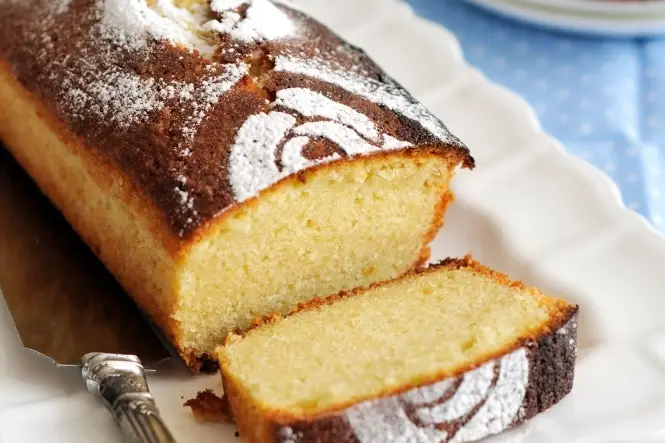So which cakes deserve to make it into the prestigious Classic category? There’s much dispute here at Cake Baker and every household seems to have its own favourite classic.
What Makes a Classic?
A cake that’s been around for generations; a cake that’s too good to disappear into the history books; the cakes you always get at fetes and tea parties? We’ve narrowed the shortlist to just a few cakes which we think really deserve a place in cake history.
In Part I of Classic Cakes we’re looking at Cherry Cake and Madeira Cake. Yes, you can buy cellophane-wrapped versions in the shops, but they’re not a patch on making your own… just try them and see.
Madeira and Cherry are both traditional classic cakes that are made by the standard ‘creaming’ method. We’ll look at this first as it’s the basis for many cakes.
The Creaming Method
You begin by sieving the flour. If you’re using a mix of flours, have to add baking powder or bicarbonate of soda, salt, or spices, now is the time to combine them. Pre-sieving the flour aerates it: extra air is allowed in and the more air we can get in, the better the cake will rise.
Next you beat the fat and sugar together. Unless the recipe specifies butter for flavour, soft margarine is ideal. Beat the mixture, preferably with an electric whisk, until it is very pale in colour and fluffy in appearance.
The eggs, which should be already lightly beaten together, are added next, a little at a time. If the mixture starts to curdle, don’t worry! Simply add a spoonful of the sieved flour in with the next lot of egg.
Then it’s time to add the rest of the flour. You do this by folding it in. That means using a slicing movement (with a metal spoon or a spatula). You don’t want to beat it at this stage as that will remove the air you’ve so carefully incorporated!
Any extra ingredients like fruit or nuts can also be folded in now.
The mixture should have a dropping consistency: if you tap a spoon on the edge of the bowl, the mixture should drop off! If it doesn’t you may need to add liquid, usually milk.
And that’s the basic creaming method. Now let’s get down to the details for these classic cakes.
Madeira Cake
Is there anything more classic than a Madeira? A favourite with all the family from children to grandparents, it’s a simple pleasure, easily-recognisable with its cracked top. Traditionally eaten accompanied by a glass of Madeira wine, today you might prefer to enjoy a slice of this buttery yellow cake with a cup of tea. Or a small glass of sherry!
Ingredients
- 110g (4oz) plain flour
- 110g (4oz) self-raising flour,
- ½ teaspoon of baking powder,
- 175g (6oz) softened butter,
- 175g (6oz) caster sugar
- 1 teaspoon vanilla essence,
- 3 large eggs
- 2 tablespoons of milk
- glacé lemon peel
Method
- Sieve 110g (4oz) plain flour and 110g (4oz) self-raising flour together with ½ teaspoon of baking powder.
- Beat 175g (6oz) softened butter, 175g (6oz) caster sugar and 1 teaspoon vanilla essence until the mixture is light and fluffy.
- Beat 3 large eggs together and add a little at a time, stirring well.
- Re-sieve the flour folding it in gradually to the mixture. If you tap the spoon on the edge of the bowl, mixture should drop off. If it doesn’t, stir in 1 or 2 tablespoons of milk.
- Put the mixture in a greased and lined 7” cake tin and bake at 180ºC, gas mark 4 for 30 minutes.
- Pop a slice or two of glacé lemon peel across the top of the cake and continue to cook for another 30 minutes. Take out of the tin and leave to cool.
Store in an airtight container. If it lasts long enough to go stale, slice it into bowls, spread with jam and serve with hot custard. Yummy!
Cherry Cake
One of the most popular yet troublesome of classic cakes is the Cherry cake. In our dreams, when we cut into the cake, the cherries are spread equally throughout; in our nightmares the cherries all end up at the bottom. To avoid this happening, make sure you wash the cherries thoroughly before you start, to remove the sticky covering. Dry and quarter them before coating them with some of the measured flour. This should stop the problem but if it doesn’t, don’t worry: the cake will still taste great!
Ingredients
- 225g (8oz) margarine,
- 225g (8oz) caster sugar,
- 225g (8oz) sifted self-raising flour (or use plain with ½ teaspoon of added baking powder),
- 4 eggs,
- lightly beaten,
- 225g (8oz) glacé cherries.
Method
Before you start put the oven on, 180°C, gas mark 4.
Grease and line the base and sides of an 8” tin – it needs to be quite deep.
- Beat the butter and sugar together until you have a pale fluffy mixture.
- Add the eggs a little a time and beat well.
- Fold in the flour and finally the prepared cherries. If the mixture looks a little dry, fold in a tablespoon of milk as well.
- Now put the cake mixture into the tin, levelling off the top.
- Sprinkle with 2 tablespoons demerara sugar and cook for 1-1½ hours until springy to the touch. If it looks as if it’s browning too much, cover with foil.
- Cool on a wire rack. Store in an airtight container.
Now you can plan your tea party! After checking our links to Everyday Fruit Cake, Scones, and, of course, The Easiest Sponge Cake Ever!

